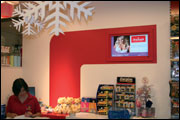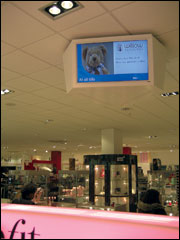 In these uncertain trading conditions, maximising shopper interest in retail outlets through exciting, attractive visual displays is paramount. Growing numbers of major UK retailers are harnessing the big screen’s persuasive power to get the message across in store, but choosing the right technology vendors is crucial. Mitsubishi Electric Europe’s (MEE) Visual Information Systems Division is working closely with its UK system integrator Icion Systems to develop and install its market leading LCD digital retail signage solutions. Mitsubishi provides the core technology, its ‘LDT’ series of Public Display Monitors, in 32″, 42″ and 46″ screen sizes, while Icion Systems supplies the complete system design and installation package. The joint proposition is proving popular with growing numbers of major retailers. The Grocery Trader went to Mitsubishi Electric Europe’s UK offices in Hatfield to meet the two companies and find out more.
In these uncertain trading conditions, maximising shopper interest in retail outlets through exciting, attractive visual displays is paramount. Growing numbers of major UK retailers are harnessing the big screen’s persuasive power to get the message across in store, but choosing the right technology vendors is crucial. Mitsubishi Electric Europe’s (MEE) Visual Information Systems Division is working closely with its UK system integrator Icion Systems to develop and install its market leading LCD digital retail signage solutions. Mitsubishi provides the core technology, its ‘LDT’ series of Public Display Monitors, in 32″, 42″ and 46″ screen sizes, while Icion Systems supplies the complete system design and installation package. The joint proposition is proving popular with growing numbers of major retailers. The Grocery Trader went to Mitsubishi Electric Europe’s UK offices in Hatfield to meet the two companies and find out more.
Fraser McDonald is Mitsubishi Electric Europe’s Visual Information Systems UK & Middle East Sales Manager. As well as digital retail signage (DRS), Fraser is responsible for Mitsubishi’s front projection division, including business data and home cinema.
The Icion management team members are James Game, the company’s Technical Director, Bob Game, the MD and Conrad Pope, Sales Director. James Game leads the Mitsubishi account relationship day to day. As Technical Director he heads up Icion’s product and business development, and ensures Icion provides customers with the required solutions. Bob Game oversees Icion’s direction and strategy, working closely with Conrad Pope and the sales team on Icion’s major corporate accounts. “Our relationship with Mitsubishi is unique,” says Bob. “They pass our UK customer feedback to their technical people in Japan, who incorporate it in product improvements.”
Mitsubishi’s Visual Information Systems products include security systems and dye sublimation printers for event photography, photo booths, and medical and security ID applications. Display screens play a growing role in the VIS portfolio, with high profile video walls and LED displays for sports arenas, such as the new Emirates stadium, but retail display is VIS’s biggest growth area overall. “The technology’s been around a while,” says Fraser, “but it’s taken time for retailers to appreciate the possible returns, despite the immense sums they spend on printed POS.”
Bob Game observes: “A major benefit that digital signage has over printed POS is the much shorter response time and guaranteed implementation. Electronic displays can convey new information about price changes and promotions instantly in every outlet on the network. By contrast, printed POS takes weeks to produce and distribute, so big fast food chains, for instance, can lose thousands if they can’t react quickly enough.” LCD displays also eliminate human error, unlike with print: “Even when it’s delivered, there’s still no guarantee store branches will implement printed POS properly.”
Digital retail solutions represent under 10% of Mitsubishi’s VIS turnover, but this is rising, says Fraser McDonald: “From our point of view, the retail display market as it is now began in 2006 and is growing month by month, as cost of ownership falls further.”
A working partnership
Set up in 2002, Icion now has 20 staff. MEE was an early partner. Bob Game explains the synergy: “It’s always great to sell products, but in this market after-sales and support are crucial. MEE feel the same way – they’re not just box shifters like other suppliers, they take an active role in our business.” A further motivator is the two companies’ proximity to each other, in Hatfield and Hoddesdon.
Icion was a system integrator for MEE’s front projection equipment before Mitsubishi launched its LCD retail signage business in 2006. James Game takes up the story: “Our LCD display screen business began in estate agency, and when department stores and other independent retailers saw it selling property successfully they asked us to help them achieve similar results.”
Conrad Pope: “The last few months have seen a huge upsurge of interest from the big grocery retailers. They are aware of big screen digital advertising, but previously saw it as too expensive for them. The fact is, now the technology’s become far more affordable, they can run their own systems and see a return on them without relying on ad revenue for income.”
 Mitsubishi provides three screen sizes, 32″, 42″ and 46″ full screen, assembled in China with Japanese quality controls in place. These offer big, bold, clear quality, says James Game: “We’re now at the digital poster stage. The 46″ full HD screen is extremely clear and bright. The screens are designed to work in high ambient light, and offer high brightness and contrast. We’ve been focusing on using them in shop windows, so deploying them internally is a natural progression. The days of dim and dingy screens in supermarkets are well and truly gone.”
Mitsubishi provides three screen sizes, 32″, 42″ and 46″ full screen, assembled in China with Japanese quality controls in place. These offer big, bold, clear quality, says James Game: “We’re now at the digital poster stage. The 46″ full HD screen is extremely clear and bright. The screens are designed to work in high ambient light, and offer high brightness and contrast. We’ve been focusing on using them in shop windows, so deploying them internally is a natural progression. The days of dim and dingy screens in supermarkets are well and truly gone.”
Fraser McDonald adds: “Retailers need to be educated – our panels are made for 24/7 commercial use, but there are still a lot of ‘consumer’ panels out there which were designed for the home market. People are also looking closely at energy saving, another area where we deliver.”
Putting it into practice
Icion’s client consultancy begins by finding out how their clients’ business works and then looking at areas where they can help improve upon it. James Game: “Retailers often believe that simply throwing in big screens will generate sales: screen placement is one of the most important decisions in the whole process, simply because they need to be visible to work effectively. In the past we have seen many major retailers placing screens in high traffic areas and high above the aisles, where they cannot be seen clearly or for long enough periods. We will always locate screens where they will be effective. One of the major priorities is to provide screens that look sympathetic, less like TVs and more like electronic posters, incorporated into furniture or recessed into walls.”
The screen size deployed depends on the detail of the information to get across, the distance from the consumer and the dwell time: “To be read 5m away, you generally need a 46″ screen or larger,” says James, “but in some aisles it could be a 32″ portrait screen. 42″ is our overall biggest selling size in the retail display market.”
Icion tailors the solution to fit, including supplying the screen’s bezel (outer casing) in the customer’s corporate colours if desired. Icion’s in store display solutions cover everything: the hardware – screens and brackets; the network – the cabling and distribution IT; managing the content for the customer, if required; and content creation and going live.
Icion recommends using different channels in store, enabling the client to target their promotions more effectively. “Larger stores with cafeterias and restaurants have a captive audience,” Bob points out. “In these areas we have a longer dwell time and can afford to add more detail to the promotions.”
James Game adds: “Running multiple channels is now easier than ever with our multiple channel Media Players allowing us to run one, two or three channels per player, which in turn keeps hardware and licensing costs down.” It’s very simple operationally, as James explains: “Retailers can manage the content, or we can do it for them: systems can be programmed to switch on and off at set times and more importantly, content can be targeted depending upon the time of day. We take ownership away from staff at store level, so branch managers and head office have responsibility.”
Mitsubishi doesn’t sell this equipment directly to retailers, but passes on enquiries to Icion to do the initial consultancy, calling in MEE for their input and presenting joint proposals. Fraser is kept informed about Icion’s retail surveys, and orders for screens can be delivered in 24 hours.
 Stand by for takeoff
Stand by for takeoff
The combined message from Mitsubishi and Icion is that UK digital signage networks are in their infancy, but are set to take off. Retailers are definitely aware of the potential, says Conrad: “The prospective clients I see want digital signage because everyone else has it. They know it works: the key is to use it smartly and ensure the clients see a tangible return on their investment.”
“Setting up digital in-store signage used to involve major initial input from the retailer with regards to content updates,” Bob recalls. “It was a lot of effort, and then six to nine months later the content hadn’t changed, so people weren’t interested. We help make it easy for retailers to deploy this effectively and it up to date.” To enable these easy updates they use technology from one of the world’s largest Digital Signage Vendors, AMX. He goes on to say, “Icion has installed the AMX Inspired Signage technology (the content management system) into more sites than any other AMX reseller worldwide.”
“Speaking to European colleagues,” says Fraser, “the UK’s one of the largest growth areas in display projection, but we’re a long way behind America.”
James elaborates: “We’re on the same level as the US technically, but in commercial psychology terms we’re only beginning to catch up. US companies regularly roll out systems to 100 stores, whilst here very few retailers will embark on a project that size and instead will try the solutions in one or two stores. Thankfully we are now seeing a change in this thinking, as the ROI is clear for all to see.”
Content to win
Icion is equipped to supply and manage the all-important content, says James: “We work closely with clients’ marketing departments, and introduce time of day-related advertising and programming to fit product launches and promotional schedules.”
Icion’s systems are simple and scalable, for a single convenience store or a large network with head office input and a marketing department: “It works like web-based publishing, with authorised inputs from different sources.” Each account is bespoke, built from the ground up, and fully supported by Icion.
What kind of material works best? James Game is clear: “Showing traditional TV ads and videos in store is generally a big no-no, because they don’t engage shoppers quickly enough. We recommend very short ads or “stings” that mimic posters and change frequently; we then add a high degree of animation and HD quality content. Shoppers’ memory retention in store is vital, so we recommend rotating no more than 10-15 ads per channel at any time.”
The bottom line
Making an impact with shoppers needn’t dent the budget. A small retailer with two screens could pay £50 per week for a complete solution: one with 20 screens using 4 channels could pay £300 per week. Fraser states plainly: “The bottom line is, if it wasn’t affordable, it wouldn’t be taking off.”
James agrees: “It’s no longer a case of us going out and selling the concept to retailers: they’re welcoming us because they need the solutions. Initially the big multiples spent fortunes on these systems, which are now available with new technology at a fraction of the price.”
Mitsubishi’s screens have a three-year warranty and a half-life of 50,000 hours. Retailers expect a return on any outlay, and in larger stores LCD displays have to work hard. Icion was recently asked to carry out a test for a major multiple, says James: “The brief was to install new digital signage and infrastructure and manage the network. They had previously tested two systems on two sites, but it wasn’t consistent. We created different messages for different areas of the store, with different ads at different times of day, and local input from the store manager about local promotions and information about local suppliers.”
Icion can point to dramatic increases in shopper foot flow and sales from implementing visually stronger displays, and have case studies to prove it, including the independent department stores Icion sold to before the supermarkets came into the marketplace.
Developing a solution can take three weeks minimum, but could be six months depending upon the project size: “the key is planning,” says James Game. “It should be a board level decision, with marketing, IT and finance all involved.” Installation and go live can happen in one day for a small store: “We pre-build everything, bring it to site, plug it in and play.” After installation, network monitoring can be done from Icion’s offices at Hoddesdon, at customers’ head offices or in individual branches. If the hardware fails, Icion is there within hours with a replacement screen.
A bright future
Both Mitsubishi Electric Europe and Icion are extremely optimistic about the future prospects for this business. Icion’s James Game says: “I see the screen technology getting bigger, brighter and more affordable. Printed point of sale material will always be there, but digital signage will increasingly be seen as complementary to it.”
Fraser McDonald agrees: “We’re so successful with Visual Display technology in the UK because we have partnerships like the one with Icion. We will continue to grow and learn from each other and stay at the forefront of the technology, offering cutting edge solutions.”
Mitsubishi Electric Europe BV
Tel: 01707 278 684
www.mitsubishielectric.co.uk/vis
Icion Systems
Tel: 0844 800 0831
www.icionsystems.co.uk




Comments are closed.